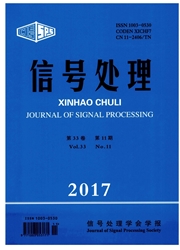

 中文摘要:
中文摘要:
适用于极化码置信传播(Belief-Propagation,BP)算法的早期终止准则研究具有实际意义。本文提出将循环冗余校验(Cyclic Redundancy Check,CRC)作为极化码BP算法的早期终止准则(简称为BP-CRC),当BP算法迭代次数大于门限后,如果信源估计值符合CRC校验,提前终止迭代;否则,就按固定迭代次数执行完BP算法。(1024,512)极化码通过二进制输入高斯白噪声信道后,提出的BP-CRC与基于生成矩阵G的早期终止准则(简称为BP-Gmatrix)做对比。仿真结果表明:在译码性能上,BP-CRC与原始BP算法基本一致;在平均迭代次数减少的效果上,和BP-Gmatrix一致;随着信噪比的增大,两者平均迭代次数减少的次数更明显。CRC比生成矩阵G检测的计算复杂度更低。平均迭代次数的减低,可以有效降低BP译码器的时延和能耗。因此,CRC是有效的低能耗和低复杂度的极化码BP算法早期终止准则。
 英文摘要:
英文摘要:
To reduce decoding latency,the research on early stopping criteria for polar Belief Propagation( BP) algorithm has practical significance. In this paper,we propose an early stopping criteria for polar BP algorithm using cyclic redundancy check( BP-CRC for short),a CRC checking is performed on the source estimated value if the number of iterations is larger than a threshold value. If the checking is passed,BP algorithm is stopped. Otherwise,BP algorithm is not stopped until a fixed number of iterations reached. For( 1024,512) Polar codes over binary-input additive white Gaussian noise channels,the simulation between BP-CRC and G-matrix stopping criterion( BP-Gmatrix for short) show the performance using the proposed algorithm is equal to that using the original BP algorithm,but the average number of iterations is significantly reduced. It was found that the reduced number of average iterations is the same both for BP-CRC and G-matrix. As the SNR increases,the reduced number of average iterations is larger. Compared to the operation of the generator matrix G,CRC has advantages of computing complexity. Moreover,the latency and energy dissipation of BP decoder can be greatly reduced with less average iterations. In summary,CRC is an effective low-power and low complexity of early stopping criteria for polar BP algorithm.
 同期刊论文项目
同期刊论文项目
 同项目期刊论文
同项目期刊论文
 期刊信息
期刊信息
